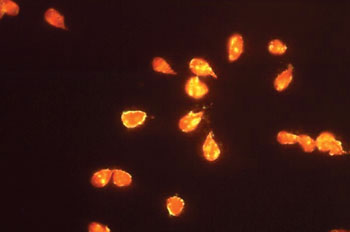Methods Compared for Detection of Fecal Giardiasis
|
By LabMedica International staff writers Posted on 27 Mar 2016 |

Image: Photomicrograph of a positive indirect fluorescent antibody (IFA) test for Giardia lamblia parasites (Photo courtesy of Dr. Govinda S. Visvesvara).

Image: Photomicrograph of stained Giardia lamblia cysts from a fecal specimen (Photo courtesy of Lynne S. Garcia, MS).
Microscopy for intestinal protozoa after formol-ether (FE) or formol-ethylacetate (FEA) concentration is standard procedure for investigating patients with diarrhea where a protozoan etiology is suspected.
In recent times, polymerase chain reaction (PCR) or fluorescence-labeled parasite-specific antibodies have been introduced for infections with intestinal protozoan parasites like Giardia duodenalis (syn. G. intestinalis and G. lamblia), Cryptosporidium but their place in everyday routine diagnostics has not yet been established.
Scientists at Aarhus University Hospital (Denmark) compared FEA and salt–sugar flotation (SSF) concentration followed by microscopy of iodine-stained concentrate and immunofluorescence assay (IFA) and real-time polymerase chain reaction (qPCR) for detection of Giardia duodenalis in human feces. Consecutive 455 fecal samples received between August 2012 and April 2013 at the hospital were included. FEA was performed within 48 hours after receipt of the samples. The samples were kept at + 4 °C for up to 90 days prior to qPCR analysis.
Immunofluorescence assays were performed on diluted feces after proper mixing, and a direct smear was made on Teflon coated slides containing three wells of 10 mm (Menzel Gläser, Braunschweig, Germany). The smears were left to air dry at room temperature overnight stained with FITC-labeled anti-Giardia antibodies (Cellabs; Brookvale Australia). Real-time polymerase chain reactions (qPCR) were performed where the crossing point-PCR-cycle (Cp) is the value given by the LightCycler 480 (Roche Diagnostics; Mannheim, Germany) and is similar to cycle threshold (Ct). It is the cycle at which fluorescence achieves a defined threshold.
The median number of Giardia cysts found by FEA in 19 Giardia-positive samples was 50 cysts per gram (CPG), by SSF 350 CPG, by IFA 76,700 CPG, and by qPCR 316,000 CPG. The team next tested 455 consecutive samples for presence of Giardia cysts. Using IFA as reference, qPCR had a sensitivity of 91%, specificity of 95.1%, a false-positive rate of 50%, a false-negative rate of 0.48%, a positive predictive value of 50%, and a negative predictive value of 99.5%.
The authors concluded that qPCR and IFA were significantly more sensitive than microscopy of iodine-stained concentrates using either FEA or SSF. They suggest, when using qPCR, that positive samples are verified by IFA to prevent false-positive results. The study was published in the March 2016 issue of the journal Diagnostic Microbiology and Infectious Disease.
Related Links:
Aarhus University Hospital
Menzel Gläser
Cellabs
In recent times, polymerase chain reaction (PCR) or fluorescence-labeled parasite-specific antibodies have been introduced for infections with intestinal protozoan parasites like Giardia duodenalis (syn. G. intestinalis and G. lamblia), Cryptosporidium but their place in everyday routine diagnostics has not yet been established.
Scientists at Aarhus University Hospital (Denmark) compared FEA and salt–sugar flotation (SSF) concentration followed by microscopy of iodine-stained concentrate and immunofluorescence assay (IFA) and real-time polymerase chain reaction (qPCR) for detection of Giardia duodenalis in human feces. Consecutive 455 fecal samples received between August 2012 and April 2013 at the hospital were included. FEA was performed within 48 hours after receipt of the samples. The samples were kept at + 4 °C for up to 90 days prior to qPCR analysis.
Immunofluorescence assays were performed on diluted feces after proper mixing, and a direct smear was made on Teflon coated slides containing three wells of 10 mm (Menzel Gläser, Braunschweig, Germany). The smears were left to air dry at room temperature overnight stained with FITC-labeled anti-Giardia antibodies (Cellabs; Brookvale Australia). Real-time polymerase chain reactions (qPCR) were performed where the crossing point-PCR-cycle (Cp) is the value given by the LightCycler 480 (Roche Diagnostics; Mannheim, Germany) and is similar to cycle threshold (Ct). It is the cycle at which fluorescence achieves a defined threshold.
The median number of Giardia cysts found by FEA in 19 Giardia-positive samples was 50 cysts per gram (CPG), by SSF 350 CPG, by IFA 76,700 CPG, and by qPCR 316,000 CPG. The team next tested 455 consecutive samples for presence of Giardia cysts. Using IFA as reference, qPCR had a sensitivity of 91%, specificity of 95.1%, a false-positive rate of 50%, a false-negative rate of 0.48%, a positive predictive value of 50%, and a negative predictive value of 99.5%.
The authors concluded that qPCR and IFA were significantly more sensitive than microscopy of iodine-stained concentrates using either FEA or SSF. They suggest, when using qPCR, that positive samples are verified by IFA to prevent false-positive results. The study was published in the March 2016 issue of the journal Diagnostic Microbiology and Infectious Disease.
Related Links:
Aarhus University Hospital
Menzel Gläser
Cellabs
Latest Microbiology News
- Breakthrough Diagnostic Technology Identifies Bacterial Infections with Almost 100% Accuracy within Three Hours
- Innovative ID/AST System to Help Diagnose Infectious Diseases and Combat AMR
- Gastrointestinal Panel Delivers Rapid Detection of Five Common Bacterial Pathogens for Outpatient Use
- Rapid PCR Testing in ICU Improves Antibiotic Stewardship
- Unique Genetic Signature Predicts Drug Resistance in Bacteria
- Unique Barcoding System Tracks Pneumonia-Causing Bacteria as They Infect Blood Stream
- Rapid Sepsis Diagnostic Test Demonstrates Improved Patient Care and Cost Savings in Hospital Application
- Rapid Diagnostic System to Detect Neonatal Sepsis Within Hours
- Novel Test to Diagnose Bacterial Pneumonia Directly from Whole Blood
- Interferon-γ Release Assay Effective in Patients with COPD Complicated with Pulmonary Tuberculosis
- New Point of Care Tests to Help Reduce Overuse of Antibiotics
- 30-Minute Sepsis Test Differentiates Bacterial Infections, Viral Infections, and Noninfectious Disease
- CRISPR-TB Blood Test to Enable Early Disease Diagnosis and Public Screening
- Syndromic Panel Provides Fast Answers for Outpatient Diagnosis of Gastrointestinal Conditions
- Culture-Free Platform Rapidly Identifies Blood Stream Infections
- POC PCR Test Rapidly Detects Bacterial Meningitis Directly at Point of Sample Collection
Channels
Clinical Chemistry
view channel
Carbon Nanotubes Help Build Highly Accurate Sensors for Continuous Health Monitoring
Current sensors can measure various health indicators, such as blood glucose levels, in the body. However, there is a need to develop more accurate and sensitive sensor materials that can detect lower... Read more
Paper-Based Device Boosts HIV Test Accuracy from Dried Blood Samples
In regions where access to clinics for routine blood tests presents financial and logistical obstacles, HIV patients are increasingly able to collect and send a drop of blood using paper-based devices... Read moreMolecular Diagnostics
view channel
D-Dimer Testing Can Identify Patients at Higher Risk of Pulmonary Embolism
Pulmonary embolism (PE) is a commonly suspected condition in emergency departments (EDs) and can be life-threatening if not diagnosed correctly. Achieving an accurate diagnosis is vital for providing effective... Read more
New Biomarkers to Improve Early Detection and Monitoring of Kidney Injury
Drug-induced kidney injury, also known as nephrotoxicity, is a prevalent issue in clinical practice, occurring when specific medications at certain doses cause damage to the kidneys. Nephrotoxicity can... Read moreHematology
view channel
New Scoring System Predicts Risk of Developing Cancer from Common Blood Disorder
Clonal cytopenia of undetermined significance (CCUS) is a blood disorder commonly found in older adults, characterized by mutations in blood cells and a low blood count, but without any obvious cause or... Read more
Non-Invasive Prenatal Test for Fetal RhD Status Demonstrates 100% Accuracy
In the United States, approximately 15% of pregnant individuals are RhD-negative. However, in about 40% of these cases, the fetus is also RhD-negative, making the administration of RhoGAM unnecessary.... Read moreImmunology
view channel
Post-Treatment Blood Test Could Inform Future Cancer Therapy Decisions
In the ongoing advancement of personalized medicine, a new study has provided evidence supporting the use of a tool that detects cancer-derived molecules in the blood of lung cancer patients years after... Read more
Cerebrospinal Fluid Test Predicts Dangerous Side Effect of Cancer Treatment
In recent years, cancer immunotherapy has emerged as a promising approach where the patient's immune system is harnessed to fight cancer. One form of immunotherapy, called CAR-T-cell therapy, involves... Read more
New Test Measures Preterm Infant Immunity Using Only Two Drops of Blood
Preterm infants are particularly vulnerable due to their organs still undergoing development, which can lead to difficulties in breathing, eating, and regulating body temperature. This is especially true... Read more
Simple Blood Test Could Help Choose Better Treatments for Patients with Recurrent Endometrial Cancer
Endometrial cancer, which develops in the lining of the uterus, is the most prevalent gynecologic cancer in the United States, affecting over 66,000 women annually. Projections indicate that in 2025, around... Read morePathology
view channel
AI Model Predicts Patient Response to Bladder Cancer Treatment
Each year in the United States, around 81,000 new cases of bladder cancer are diagnosed, leading to approximately 17,000 deaths annually. Muscle-invasive bladder cancer (MIBC) is a severe form of bladder... Read more
New Laser-Based Method to Accelerate Cancer Diagnosis
Researchers have developed a method to improve cancer diagnostics and other diseases. Collagen, a key structural protein, plays various roles in cell activity. A novel multidisciplinary study published... Read more
New AI Model Predicts Gene Variants’ Effects on Specific Diseases
In recent years, artificial intelligence (AI) has greatly enhanced our ability to identify a vast number of genetic variants in increasingly larger populations. However, up to half of these variants are... Read more
Powerful AI Tool Diagnoses Coeliac Disease from Biopsy Images with Over 97% Accuracy
Coeliac disease is an autoimmune disorder triggered by the consumption of gluten, causing symptoms such as stomach cramps, diarrhea, skin rashes, weight loss, fatigue, and anemia. Due to the wide variation... Read moreTechnology
view channel
Smartphones Could Diagnose Diseases Using Infrared Scans
Rapid advancements in technology may soon make it possible for individuals to bypass invasive medical procedures by simply uploading a screenshot of their lab results from their phone directly to their doctor.... Read more
Novel Sensor Technology to Enable Early Diagnoses of Metabolic and Cardiovascular Disorders
Metabolites are critical compounds that fuel life's essential functions, playing a key role in producing energy, regulating cellular activities, and maintaining the balance of bodily systems.... Read more
3D Printing Breakthrough Enables Large Scale Development of Tiny Microfluidic Devices
Microfluidic devices are diagnostic systems capable of analyzing small volumes of materials with precision and speed. These devices are used in a variety of applications, including cancer cell analysis,... Read moreIndustry
view channel




















